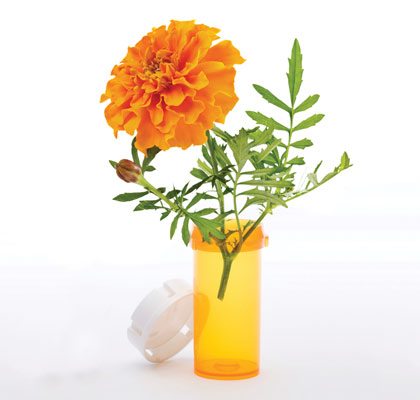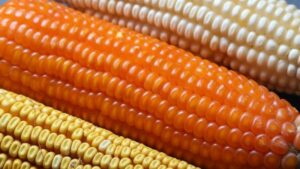A look at how one company went from growing ornamental flowers to supplying the nutraceutical market with carotenoids.
Marigolds are pretty to look at and can easily capture the eye, but they can also aid in eye health. Creating and breeding beautiful plants is one of the hallmarks of the 100-year-old Ball Horticultural Company in West Chicago, Illinois. So when the family-owned business discovered that one of its ornamental flowers could actually benefit eye health, the seed company ventured into new territory and entered the nutraceutical market.
“Basically, we took a plant that you could grow in your garden and we have bred it for an industrial purpose,” explains Alan Blowers, biotechnology project manager for Ball Helix, the internal biotech division of Ball Horticultural Company.
Traditionally, African marigolds, which are grown in the masses in the western hemisphere, have been used to supplement chicken feed, which gives broilers a nice yellow tone to the skin or a nice yellow egg yolk, Blowers says.
Today, those fields of marigolds are harvested for the nutraceuticals market. A little more than 20 years ago, clinical and primate studies began to show that two carotenoids, zeaxanthin and lutein, helped when it came to macular degeneration.
Lutein and zeaxanthin are the only antioxidants that are found in the retina of the eye, where they protect the eye from the development of cataracts and macular degeneration, reports the Linus Pauling Institute, a research institute located at Oregon State University.
“If we had the right mutation, but it couldn’t survive in the field, it was of no interest to us.” — Alan Blowers
“When people were given diets that were adjusted or deficient in those, you saw clear beneficial effects when those diets were supplemented with lutein and zeaxanthin,” Blowers says. “Then, the National Institute of Health funded eye studies, which substantiated those results.”
Evidence showed that lutein and zeaxanthin, found in marigolds — not beta-carotene, which is the dominant carotenoid in carrots — are necessary for optimal eye health.
Blowers, who has been working on the marigold project for 10 years, explains that his team needed to tweak the genes and modify a particular pathway so the carotenoids could use utilized as a supplement.
“We wanted to modify the pathway in how the carotenoids are produced and the nature of the carotenoids that are produced,” Blowers says. “We knew that we could create the mutations that we needed, and we knew that we could identify them in the genes. But you’re talking about disrupting some pretty major conserved pathways in the plants.”
Beginning With the End
Blowers explains that his team knew from literature that there could be some effects on the plants that could affect their field fitness. From the beginning his team was cognizant of the fact that the marigolds needed to be field worthy. So the team began their screening in the field.
“If we had the right mutation, but it couldn’t survive in the field, it was of no interest to us,” Blowers notes.
Additionally, because they were breeding a product that in the end would be targeted for the natural market, the Ball team chose not to use genetic engineering in the breeding process.
“We felt the end product would be better accepted if it came from a natural breeding process versus a genetically engineered product,” Blowers explains, noting that the time to get to market would also be much faster due to fewer regulatory hurdles. “We took the path of least resistance.”
Today, these marigolds are turned into supplements that support eye health and are available under a wide range of private labels, according to Blowers.
According to a 2012 report by Global Information Inc., the global market for nutraceuticals is projected to reach $250 billion by 2018. The report’s authors estimate that “By the year 2020, the number of individuals who are aged 60 years and above is expected to surpass 1 billion. … The nutraceuticals industry is geared to meet the rising demand for health foods and products as companies with sufficient capital for scientific research enter the nutraceuticals space.” It’s stats such as these that make neutraceuticals a lucrative market.
According to Chrysantis, a grower of Ball marigolds, the typical marigold carotenoid profile is 80 percent lutein and 5 percent zeaxanthin. With the breeding work done by Blowers’ team, marigolds can be grown with profiles ranging from 75 percent zeaxanthin and 5 percent lutein to 50 percent zeaxanthin and 50 percent lutein.
“We can do some very innovative things in flower breeding,” Blowers says.
Julie Deering















